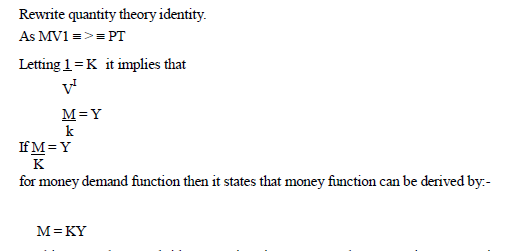This was an extension of quantity theory of money where the exchange equation is stated
as Cambridge equation from Cambridge University.
M = kY - Cambridge
It's derived from quality theory demand for money (MV = PT) .Assumes that transactions
are proportional to real income.
If T = AY
Then MV = PT = AYP
Where Y is money income


In this case the Cambridge equation incorporates the Keynesian transactions and precautionary demand for money but not the speculations demand. Cambridge economists state that if there was an increase in supply of money while initially price and income remained unchanged, people would find themselves holding more money than they wished to hold. Their response to this situation is to spend the money on other assets that yield a return and perhaps on consumption goods as well.
However assuming a condition of full employment as indicates by constant income Y (output). Thus attempts by everyone to buy more goods are only going to push prices up. Also it is apparent that although one individual may diminish his money but economy as a whole cannot since the money supply is assumed exogenous. One individual?s decreasing of his money holdings, leads to another increasing of his money holding.
Hence the process of adjustment of the money market to the increase money supply is through a rise in price level and hence also in the level by money income transactions and wealth which induces an increase in the demand for money.
Wilfykil answered the question on
March 8, 2019 at 10:42